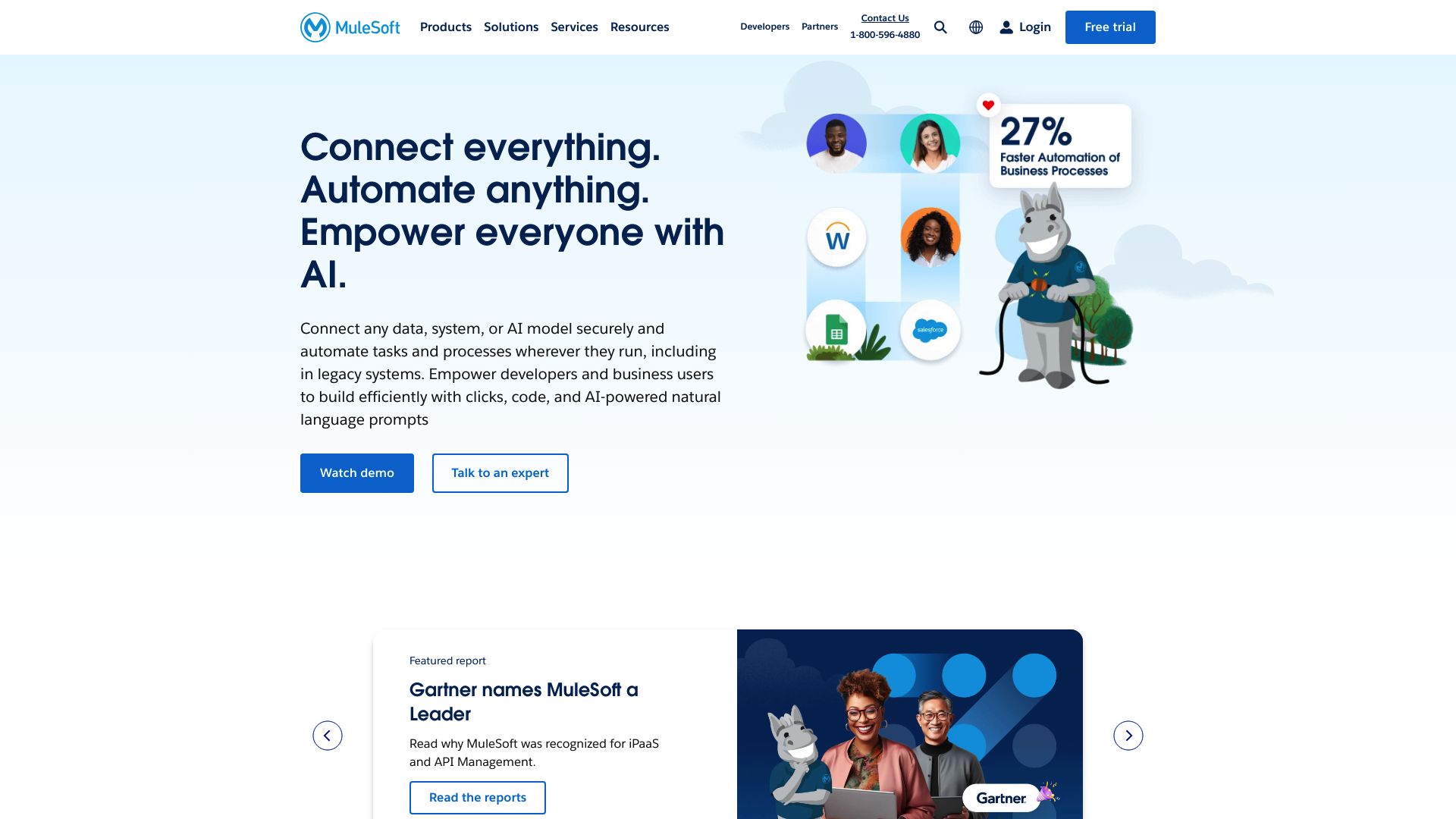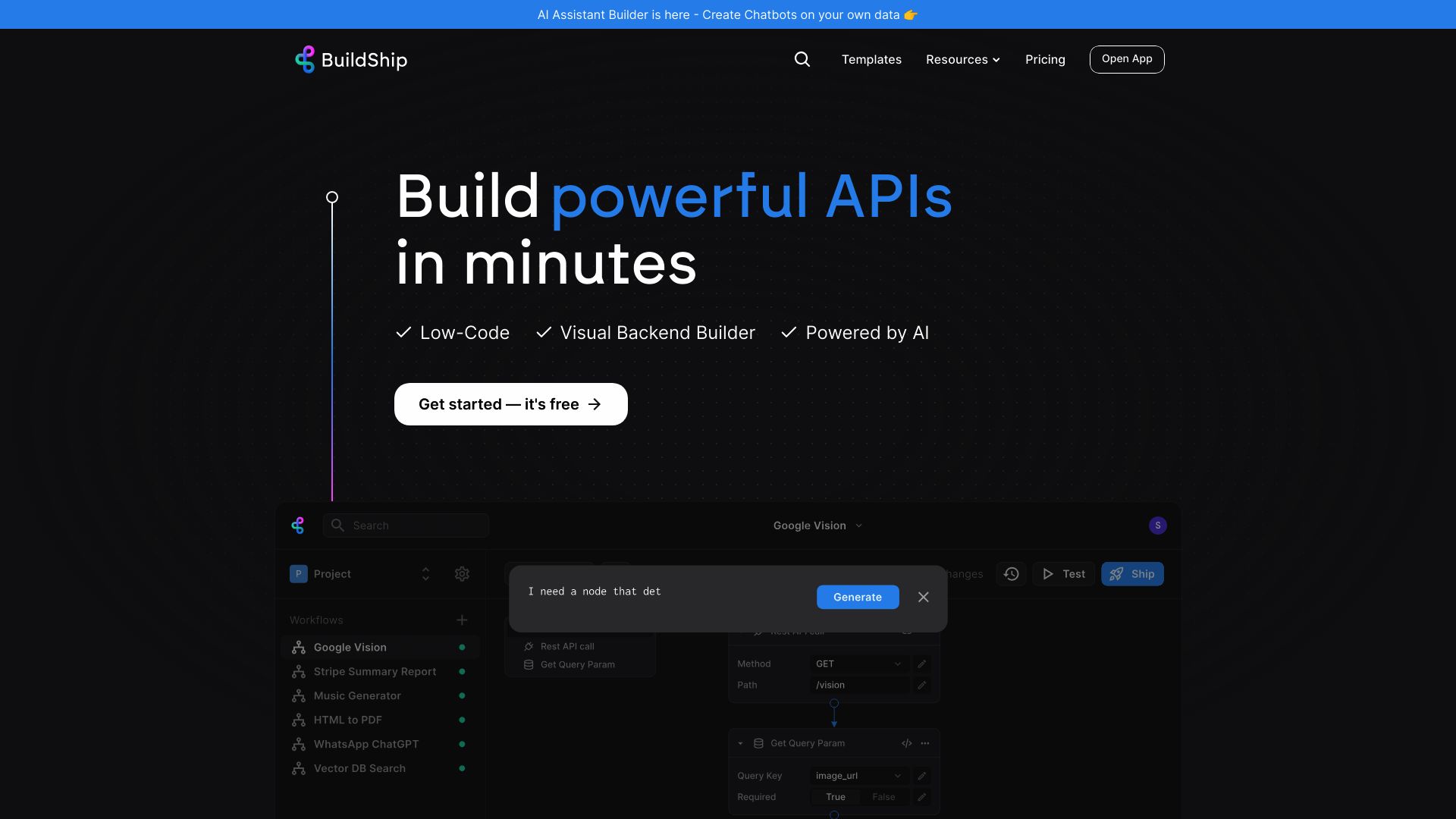Mulesoft vs. BuildShip: Enterprise Integration or No-Code Workflows?
The AI revolution promises to transform businesses, but choosing the right platform can be daunting. Our comparison of Mulesoft vs. BuildShip, and SmythOS cuts through the hype, offering a clear-eyed analysis of each platform’s strengths and limitations. We examine how these tools tackle enterprise integration, workflow automation, and AI deployment, highlighting key differences in API management, security features, and ease of use.
Whether you’re a seasoned developer or a business leader exploring AI solutions, this guide equips you with the insights to make an informed decision. Discover which platform best aligns with your integration needs, development capabilities, and AI ambitions.
Mulesoft Overview
Mulesoft revolutionizes enterprise connectivity with its powerful integration platform. The Anypoint Platform enables businesses to design, build, and manage APIs, fostering seamless data exchange across disparate systems. This solution particularly benefits large enterprises grappling with complex IT ecosystems, offering a unified approach to integration challenges.
Mulesoft revolutionizes enterprise connectivity with its powerful integration platform. The Anypoint Platform enables businesses to design, build, and manage APIs, fostering seamless data exchange across disparate systems.


Mulesoft excels in API-led connectivity, allowing organizations to create reusable assets that accelerate digital transformation. Its integration with Einstein AI enhances developer productivity, enabling rapid project initiation through natural language prompts. The platform’s robust security features, including Anypoint Flex Gateway, ensure controlled API management—critical for safeguarding sensitive data in AI and integration processes.
Mulesoft excels in API-led connectivity, allowing organizations to create reusable assets that accelerate digital transformation.
The Anypoint Studio visual development environment simplifies API design, while Flow Builder empowers non-technical users to create integrations without coding. Mulesoft’s support for AI model integration, including OpenAI and custom models, expands its capabilities for chatbots, predictive analytics, and automated decision-making.
Mulesoft’s scalability shines in its deployment options, spanning CloudHub, on-premises runtimes, and Kubernetes solutions. This flexibility allows businesses to choose optimal environments for their specific needs. However, the platform’s extensive features may present a learning curve for smaller organizations or those new to API management.
Mulesoft’s scalability shines in its deployment options, spanning CloudHub, on-premises runtimes, and Kubernetes solutions.
In the competitive landscape, Mulesoft stands out for its comprehensive approach to integration and AI-enhanced capabilities. Its strengths lie in enterprise-grade scalability, robust security, and an extensive ecosystem of connectors. While it offers powerful tools for experienced developers, the platform also caters to citizen integrators through low-code options, positioning it as a versatile solution for diverse integration needs.
BuildShip Overview
BuildShip empowers users to create, test, and deploy backend workflows and APIs without extensive coding knowledge. The platform’s visual no-code interface allows developers and non-technical users alike to build complex automations using a drag-and-drop workflow builder.
At its core, BuildShip offers prebuilt nodes for common tasks while also leveraging AI to generate custom nodes based on natural language prompts. This AI-assisted development accelerates the creation of workflows by reducing the need for manual coding. Users can integrate various data sources, APIs, and AI models to construct powerful backend processes.


BuildShip caters to developers seeking rapid prototyping and non-technical users aiming to automate business processes. The platform’s testing capabilities enable iterative development, allowing users to refine individual nodes and entire workflows before deployment. Once perfected, these workflows can be deployed as production-grade APIs, seamlessly integrating into existing applications.
BuildShip empowers users to create, test, and deploy backend workflows and APIs without extensive coding knowledge.
While BuildShip excels in simplifying backend development, it faces challenges in highly specialized or complex use cases that may require extensive customization. The platform’s reliance on prebuilt components and AI-generated nodes may limit flexibility for advanced users needing granular control over every aspect of their workflows.
BuildShip’s focus on backend automation and API creation positions it as a valuable tool for businesses looking to streamline operations and reduce development time. By combining visual programming with AI assistance, the platform bridges the gap between no-code simplicity and the power of custom backend solutions.
Feature Comparison
Mulesoft and BuildShip offer contrasting approaches to integration and workflow automation. Mulesoft provides a comprehensive enterprise integration platform with robust API management capabilities. BuildShip focuses on simplified backend workflow creation using a visual no-code interface.
In core components, Mulesoft’s Anypoint Platform delivers full API lifecycle management, including design, implementation, deployment, and monitoring. Its enterprise-grade features support complex integrations across diverse systems. BuildShip, conversely, emphasizes rapid backend workflow development through drag-and-drop tools and AI-assisted node generation. While powerful for quickly prototyping and deploying APIs, BuildShip may lack some of Mulesoft’s advanced enterprise integration capabilities.
Security represents another key differentiator. Mulesoft’s Anypoint Flex Gateway and extensive governance tools provide enterprise-level API security and access control. BuildShip’s security offerings appear more limited, potentially making it less suitable for organizations with stringent compliance requirements or handling highly sensitive data. For businesses prioritizing robust security in their integration architecture, Mulesoft likely holds an advantage.
Feature Comparison Table
| Mulesoft | BuildShip | SmythOS | |
|---|---|---|---|
| CORE FEATURES | |||
| Memory & Context | ❌ | ❌ | ✅ |
| Autonomous Agents | ✅ | ❌ | ✅ |
| Explainability & Transparency | ❌ | ❌ | ✅ |
| Multimodal | ✅ | ❌ | ✅ |
| Problem-Solving Capabilities | ❌ | ❌ | ✅ |
| Multi-Agent Collaboration | ✅ | ❌ | ✅ |
| Human-AI Interaction | ❌ | ❌ | ✅ |
| Audit Logs for Analytics | ❌ | ❌ | ✅ |
| Work as Team | ✅ | ❌ | ✅ |
| SECURITY | |||
| Constrained Alignment | ✅ | ❌ | ✅ |
| Data Encryption | ❌ | ✅ | ✅ |
| COMPONENTS | |||
| Foundation AIs | ✅ | ❌ | ✅ |
| Huggingface AIs | ❌ | ❌ | ✅ |
| Zapier APIs | ❌ | ❌ | ✅ |
| All other APIs, RPA | ❌ | ✅ | ✅ |
| Classifiers | ✅ | ❌ | ✅ |
| Logic | ❌ | ✅ | ✅ |
| Data Lakes | ✅ | ❌ | ✅ |
| DEPLOYMENT OPTIONS (EMBODIMENTS) | |||
| Staging Domains | ✅ | ❌ | ✅ |
| Production Domains | ✅ | ❌ | ✅ |
| Deploy as Site Chat | ✅ | ❌ | ✅ |
| Deploy as Scheduled Agent | ❌ | ✅ | ✅ |
| Deploy as GPT | ✅ | ❌ | ✅ |
| Scalability | ❌ | ✅ | ✅ |
| DATA LAKE SUPPORT | |||
| Hosted Vector Database | ✅ | ❌ | ✅ |
| Sitemap Crawler | ❌ | ❌ | ✅ |
| YouTube Transcript Crawler | ❌ | ❌ | ✅ |
| URL Crawler | ❌ | ❌ | ✅ |
| PDF Support | ❌ | ❌ | ✅ |
| Word File Support | ✅ | ❌ | ✅ |
| TXT File Support | ✅ | ❌ | ✅ |
Best Alternative to Mulesoft and BuildShip
SmythOS emerges as the superior alternative to Mulesoft and BuildShip for agentic AI automation. Our platform combines powerful features with unmatched ease of use, enabling rapid development of sophisticated AI agents for unlimited use cases. SmythOS delivers enterprise-grade capabilities through an intuitive drag-and-drop interface, empowering both developers and non-technical users to harness AI’s full potential.
SmythOS emerges as the superior alternative to Mulesoft and BuildShip for agentic AI automation… enabling rapid development of sophisticated AI agents for unlimited use cases.
Unlike Mulesoft’s complex integration platform or BuildShip’s limited workflow builder, SmythOS provides a comprehensive ecosystem for creating, deploying, and managing intelligent agents. We offer seamless integration with leading AI models, extensive API connectors, and flexible deployment options — capabilities neither Mulesoft nor BuildShip can match. SmythOS agents leverage advanced memory and context tracking to deliver more natural, contextually-aware interactions across channels.
Security and scalability set SmythOS apart. While Mulesoft focuses heavily on API security, it lacks SmythOS’s end-to-end encryption and flexible deployment across environments. BuildShip offers basic workflow security but cannot match our enterprise-grade features. SmythOS ensures data protection and compliance at every level while enabling agents to scale effortlessly to meet growing demands.
SmythOS ensures data protection and compliance at every level while enabling agents to scale effortlessly to meet growing demands.
Perhaps most importantly, SmythOS unlocks AI’s transformative potential for any use case. Our platform supports multimodal interactions, autonomous problem-solving, and seamless collaboration between human teams and AI agents. Whether you’re building customer service chatbots, automating complex business processes, or developing cutting-edge AI applications, SmythOS provides the ideal foundation. With our intuitive tools and unmatched flexibility, the possibilities are truly limitless.
For organizations seeking to harness AI’s full power through a unified, user-friendly platform, SmythOS stands alone as the clear choice over Mulesoft and BuildShip. Experience the future of AI automation — try SmythOS today and unlock innovation across your enterprise.
Conclusion
Mulesoft and BuildShip offer distinct approaches to integration and workflow automation. Mulesoft excels in enterprise-grade API management and complex system integrations, making it ideal for large organizations with sophisticated IT ecosystems. BuildShip, with its no-code interface and AI-assisted development, caters to users seeking rapid backend workflow creation and API deployment.
While both platforms have their strengths, SmythOS emerges as the superior choice for businesses looking to harness the full potential of AI-driven automation. Our platform combines the best of both worlds – enterprise-level capabilities and user-friendly design – while pushing the boundaries of what’s possible with AI integration.
SmythOS’ drag-and-drop interface rivals BuildShip’s ease of use, while our extensive integration ecosystem matches and exceeds Mulesoft’s connectivity options. We offer unparalleled flexibility in AI model support, seamless multi-agent collaboration, and versatile deployment options that neither competitor can match. Our platform empowers users to create sophisticated AI workflows 99% faster, democratizing AI development across industries.
To experience the future of AI automation firsthand, create a free SmythOS account today. Start building AI agents with no time limit and explore our diverse range of AI-powered agent templates to jumpstart your projects. Whether you’re looking to streamline operations, enhance customer engagement, or drive innovation, SmythOS provides the tools and capabilities to transform your ideas into reality. Unleash the power of AI for your business and join the AI revolution with SmythOS.
Last updated:
Disclaimer: The information presented in this article is for general informational purposes only and is provided as is. While we strive to keep the content up-to-date and accurate, we make no representations or warranties of any kind, express or implied, about the completeness, accuracy, reliability, suitability, or availability of the information contained in this article.
Any reliance you place on such information is strictly at your own risk. We reserve the right to make additions, deletions, or modifications to the contents of this article at any time without prior notice.
In no event will we be liable for any loss or damage including without limitation, indirect or consequential loss or damage, or any loss or damage whatsoever arising from loss of data, profits, or any other loss not specified herein arising out of, or in connection with, the use of this article.
Despite our best efforts, this article may contain oversights, errors, or omissions. If you notice any inaccuracies or have concerns about the content, please report them through our content feedback form. Your input helps us maintain the quality and reliability of our information.
